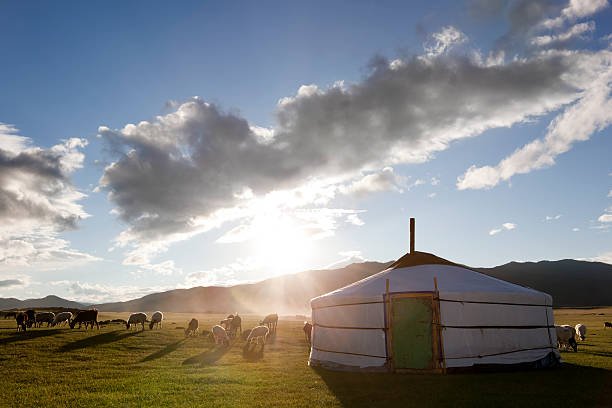Yurt tent kits allow you to quickly and easily set up a sturdy, spacious, and cozy yurt tent for camping, glamping, or even full-time off-grid living. These round tent kits come with all the materials you need to assemble a yurt in just a few hours. In this comprehensive guide, we will cover everything you need to know about yurt tent kits, including:
What is a Yurt Tent Kit?
- A yurt is a circular tent with a conical or domed roof traditionally used by nomadic groups in Central Asia. Modern yurt kits allow you to assemble a yurt tent using pre-cut materials and easy instructions.
- Yurt kits include canvas or fabric for the walls and roof, wooden lattice frames, doors, windows, roof rings, ropes, stakes, and detailed setup instructions.
- Yurt tent sizes typically range from 10-30 feet in diameter. Larger yurt kits are available for more permanent structures.
- Yurt kits take only a few hours to assemble with 2-3 people and basic DIY skills. They can be easily disassembled for storage or transport.
Benefits of Yurt Tent Kits
- Pre-cut Materials: Everything you need for assembly is included and precisely cut to size. This makes setup much easier.
- Sturdy Design: Yurt tents stand up very well to wind and weather when properly staked down. The lattice frames provide stability.
- Spacious Interior: The circular floor plan creates an open, comfortable living space with no wasted corners.
- Energy Efficient: The thick canvas tent holds heat during cold weather and stays cooler in the summer.
- Great Airflow: The central roof opening allows hot air to exit while providing light and views.
- Flexible Usage: Yurts work great as a temporary shelter or more permanent dwelling with some insulation and accessories.

What to Look for in a Quality Yurt Tent Kit
To choose the best yurt tent kit for your needs, here are some key factors to consider:
- Diameter: Consider the size yurt you need to comfortably fit your intended purpose. 10-20 feet is ideal for most camping needs.
- Wall Material: Cotton canvas is durable, breathable, and authentic for a traditional yurt look. Synthetic fabrics like polyester are cheaper but less breathable.
- Roof Material: Vinyl or acrylic-coated polyester is waterproof and allows light to enter. PVC is sturdier but blocks light.
- Frame Material: Hardwood like pine is sturdy but heavy. Lightweight metal alloys are easier to transport but may be less durable.
- Insulation: An inner insulated wall or liner helps retain warmth in cold climates.
- Accessories: Look for a kit with useful additions like stove jack, flooring, doors, insulation, furniture, and more.
- Ease of Setup: Pick a yurt that can be assembled in a few hours with minimal tools and people required.
- Portability: Consider weight and breakdown size if you plan to move your yurt tent frequently.
- Warranty: A good warranty of 1-5 years protects against defects in materials or workmanship.

Where to Buy Yurt Tent Kits
There are several options for purchasing yurt tent kits:
- Direct from Manufacturer: Buying directly from the source often provides the best price on large kit packages.
- Online Retailers: Many online specialty shops offer a wide selection of yurt kits with convenient shipping.
- DIY Plans: You can sometimes purchase just the plans to precision-cut the materials yourself and save money.
- Used Yurts: It may be possible to find used yurt kits sold by previous owners through classified ads or auction sites.
Some top manufacturers and retailers to buy from include Pacific Yurts, Rainier Yurts, Colorado Yurt Company, Yukon Yurts, and more. Be sure to compare pricing, components, and policies.

Required Tools and Materials
Yurt tent kits provide most of what you need, but you will need to supply a few additional tools and materials:
- Stakes: Sturdy metal or plastic stakes to secure the yurt to the ground (may be included)
- Mallet: For pounding in the stakes
- Rope: Additional ropes or tension cables for added stability
- Power Drill: For driving screws into the frame quickly
- Shovel: For leveling the site if needed
- Ladder: For roof access and installation
- Sealant/Caulk: For sealing joints against leaks
- Insulation: If not included, to add additional comfort
- Lighting: Portable lighting if being used at night
- Furniture: Chairs, cots, air beds, etc. as desired for interior use
How to Assemble a Yurt Tent Kit
Follow these general steps to assemble your yurt tent kit once you have prepped the site:
1. Layout the Frame Pieces
- Lay out all of the sidewall lattice pieces end-to-end in a circle.
- Leave a gap for the door according to the instructions.
- Join the pieces together with the provided hardware to form the wall frame.
2. Install the Roof Ring
- Position the roof ring at the top of the wall frame and bolt it securely in place per the specifications.
- The ring should sit centered on the walls with a slight overhang.
3. Attach the Roof Ribs
- Next, attach the roof ribs which extend from the top ring down to the center roof opening.
- Use the provided angle braces to hold the ribs in the correct position.
4. Cover the Walls
- Once the frame is assembled, drape the canvas wall covering over the frame.
- Pull it taut and lace or velcro it securely to the frame on the inside.
5. Add the Roof Canvas
- Climb up via a ladder to drape and secure the roof covering over the roof ribs, creating a conical shape.
- Seal any major gaps or openings.
6. Insert Doors, Windows, and Stove Jacks
- If included, install the vinyl windows and door panels into their corresponding openings by lacing them into the frame.
- Insert any stove jack into the top vent hole and seal around it.
7. Stake Down the Yurt
- Use the provided stakes and a mallet to securely stake the yurt to the ground through the loops on the lower wall edge.
- Consider using snow or sandbags for added winter stability if needed.
- The central rope provides extra anchoring.
You now have a complete yurt ready for furnishing and inhabiting! Remember to properly maintain and waterproof the canvas.

Yurt Tent Living Setup Considerations
If using your yurt tent kit for longer-term living, here are some setup tips:
- Platform: Build a level wooden platform to elevate the floor and prevent moisture and critters.
- Insulation: Add an inner wall liner and insulation for thermal regulation and condensation control.
- Furniture: Outfit the interior with cots, seating, tables, storage, and modular furniture. Consider weight.
- Electricity: Solar panels, generators, and deep-cycle batteries can power lighting, appliances, and electronics.
- Heating/Cooling: Airtight wood stoves work well. Propane and electric heaters are options too. Fans keep air circulating.
- Plumbing: Composting, incinerating or portable toilets address bathroom needs. Solar showers and sinks can be added.
- Cooking: Portable camp stoves, propane ranges, or indoor electric stoves allow cooking indoors or out.
- Flooring: Install wooden floor sections or platforms, brick pavers, removable rugs, or outdoor carpeting for comfort and decor.
With some creativity, you can outfit a yurt tent with all the amenities and comforts of a modern home!
Yurt Tent Kit Frequently Asked Questions
1. How difficult is it to assemble a yurt tent kit?
Yurt kits are designed for straightforward assembly by two to three people with basic skills in just a few hours. All materials are pre-cut and include step-by-step instructions. The basic lattice structure installs quickly before covering with the canvas.
2. What maintenance is required for a yurt tent?
Periodically tighten any joints that become loose. Apply seam sealer on the canvas as needed, especially around any stove pipes. Waterproof treatments will need reapplied every 1-2 years. Properly ventilate and control moisture inside.
3. How well do yurts withstand wind, rain, and snow?
The sturdy lattice framework and tight canvas help yurts stand up to all but the most extreme weather when properly anchored down. Extra precautions are needed in snow, like using snow cleats on the roof to prevent collapse from the weight.
4. What size yurt do I need for sleeping and living space?
- 10-12 feet: 2-3 people
- 16-20 feet: 4-6 people
- 24-30 feet: 8-10+ people
Consider your furnishings too. Bigger is better for full-time living.
5. Can you heat and cool a yurt tent?
Yes! Wood stoves with chimneys vented through the roof work very well for heating. Kerosene and propane heaters are portable options too. Fans, roof vents, and windows help with ventilation and cooling in warm months.
6. How much does a basic yurt tent kit cost?
Pricing can range anywhere from $1000 for a small simple kit to $4000+ for a large deluxe kit made with premium materials and components. The diameter, features, and add-ons impact the cost.
7. Do you need a permit to live in a yurt?
It depends on the location. Often, temporary yurt camping is permit-free. However residing full-time may require standard building permits, zoning variances, or codes for plumbing, electric, etc. Check local regulations.
8. Are yurts energy efficient?
The thick, dense canvas retains heat well. With proper insulation and airtight stoves, yurts can be very energy efficient. The round shape also reduces the surface area which loses heat compared to square buildings. Proper site selection using natural wind barriers and shade is important too.
Closing Thoughts
Yurt tent kits provide one of the quickest, easiest, and most affordable ways to obtain a spacious, sturdy, and comfortable shelter – whether for temporary camping or more permanent off-grid living needs. With just basic DIY skills and a few tools, these complete kits can be transformed into the round tent home of your dreams in just a few hours.
Consider what size and features fit your plans, and look for quality materials from reputable manufacturers that will stand the test of time. With the right setup, yurts are capable of withstanding all kinds of weather and keeping you cozy inside no matter what may come your way.












